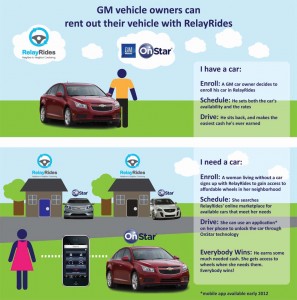Sure, you’ve got a long commute, but the fact is that your car – and most others – sit around most of the day when they could be put to better use. Or so is the theory behind RelayRides, which takes an offbeat approach to put cars to better use when they’d otherwise be sitting idle.
Teaming up with OnStar, RelayRides – which is backed by money from Google Ventures – provides an alternative to traditional car rental firms. Someone who might need a car, say, to run a couple errands, could access a vehicle from someone living down the block or working in a nearby office.
The system is designed to make a short-term rental quick and easy — and even to give a user a wide range of vehicle choices. Owners, meanwhile, could get a chunk of change that could be applied to their monthly car payment — or gas bill.
As part of an exclusive relationship that will begin in early 2012, the car-sharing service will focus on GM vehicles equipped with OnStar. That would seem to make sense because unlike many competing telematics systems, a vehicle with OnStar has a built-in data link that doesn’t depend on having the owner’s cellphone nearby.
An OnStar operator thus could unlock the door of a vehicle for an authorized RelayRides user. Otherwise, someone participating in the car-sharing venture would have to install a special device in the vehicle to allow access.
“RelayRides has always worked toward providing the safest, most advanced, peer-to-peer carsharing marketplace, where neighbors can help out one another by making their frequently unused car available to those who live nearby,” said RelayRides Chief Executive Officer André Haddad. “With the new GM relationship, RelayRides can leverage the OnStar technology to make carsharing even more convenient, with nothing more than a mobile app. Carsharing has never been easier.”
Someone who might want to make a vehicle available through the service can sign up online and then set their own price – though a RelayRides spokesperson suggests it makes sense to keep it competitive to generate some business. After an inspection approved vehicles are offered to RelayRides customers who pay by the hour.
The typical vehicle is relatively new, though the available products range from sports cars to hybrids in the two cities where the service is now available, Boston and San Francisco.
RelayRides claims the average vehicle is generating $250 in revenue a month. Of that, 65% goes into the pocket of the vehicle owner, 20% covers insurance and the remaining 15% is kept by RelayRides.
“We’re using technology to make both our older and newest models carshare ready and available for those owners who choose to participate in carsharing,” said Stephen Girsky, GM vice chairman. “Our goal is to find ways to broaden our customer reach, reduce traffic congestion in America’s largest cities and address urban mobility concerns.”
The partnership, it appears, is aimed at helping expand the use and awareness of both GM vehicles and the OnStar service – which currently claims an active subscriber base of 6 million.
The concept of carsharing is gaining traction in many parts of the world, especially in crowded urban areas where vehicle ownership can be a costly hassle. In Paris, the city has just begun a program which makes available small electric vehicles that can be picked up in one neighborhood and then dropped off at a reserved parking spot on the other side of town without a penalty.
Perhaps the best-known name in the U.S. is ZipCar, which provides a fleet of vehicles that are typically parked at dedicated spots in communities like Austin, Texas.
The key difference, according to the RelayRides spokesman, is that “these are cars owned by your neighbors.”
The carshare concept, while generating strong buzz from environmentalists and urban planners, still isn’t proving itself financially viable, though proponents insist it will take some time before the public catches on and makes use of such ventures as ZipCar and RelayRide in substantial numbers.

